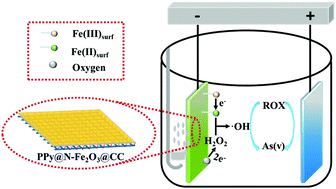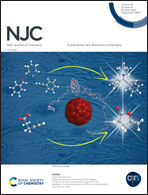Constructing PPy-encapsulated needle-like Fe2O3 nanoarrays on carbon cloth as electro-Fenton cathodes for high efficiency roxarsone degradation
Abstract
Carbon cloth with polypyrrole (PPy)-encapsulated needle-like Fe2O3 nanoarrays (PPy@N-Fe2O3@CC) was grown and tested as an electro-Fenton cathode for roxarsone degradation. The multifunctional cathode was characterized by scanning electron microscopy (SEM), transmission electron microscopy (TEM), X-ray diffraction (XRD) and more. At an initial pH of 4.0, cathodes coated with PPy degraded roxarsone 3.5 times faster than uncoated cathodes (N-Fe2O3@CC). This significant enhancement was attributed to the conducting effect of PPy, which can bridge the electronic channel between Fe2O3 and the carbon cloth, which is convenient for the electro-reduction of Fe(III) to Fe(II). Little iron leached from the electrode due to the protective effect of the PPy layer. After five reaction cycles, the PPy@N-Fe2O3@CC cathode could still reach at least 93% roxarsone degradation. The effects of applied current and pH on the degradation of roxarsone were also investigated. The result of high-performance liquid chromatography-hydride generation-atomic fluorescence spectrometry (HPLC-HG-AFS) showed that roxarsone was degraded to As(V). This work demonstrates that an electro-Fenton system using PPy@N-Fe2O3@CC as a cathode is promising for organic wastewater treatment.



 Please wait while we load your content...
Please wait while we load your content...